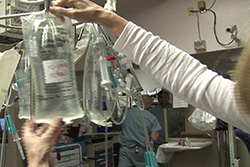容量治療的7種錯誤概念
這是輸液治療的一篇很好的編輯觀點,刊載在Br J Anaesth 2009 103(2):147-151;
Seven misconceptions regarding volume therapy strategies—and their correction
- First misconception: saline is a physiological solution
- Second misconception: albumin is superior to other plasma substitutes
- Third misconception: all colloids are the same
- Fourth misconception: crystalloids are as effective as colloids
- Fifth misconception: use of pressure-related monitoring variables to guide volume therapy
- Sixth misconception: mortality is the only variable that counts for assessing the quality of volume replacement strategies
- Seventh misconception: the myth of meta-analyses
誤區五 監測壓力相關的變量來指導容量治療
合理的監測目的是避免灌注不足或者液體過多。標準的血液動力學監測如監測血壓和心率在監測容量不足和指導容量治療方面常常不準確。充盈壓(中心靜脈壓和肺動脈楔壓)在準確評價左室前負荷方面有一定的誤導性。心臟充盈壓除了容量負荷外還受幾個因素的影響,如血管和心室順應性的改變。胸內血容量(ITBV)已經報導是一種監測容量替代治療的更好的方法。用ITBV監測可以減少ICU和住院的時間,死亡率也會下降。但ITBV只是描述充盈的一個靜態的指標,不是一個監測血流和灌注的動態的過程。
隱匿性的低容量血症可能會發展成為器官灌注不足和後面的器官功能不全。監測心臟輸出量和中心靜脈的氧飽和度較單純監測血壓在評價容量替代治療是否足夠方面更可靠。在個別的目標導向性治療中通過動態指標如心輸出量和中心靜脈氧飽和度指導可以明顯改善患者的預後。
1. 標準的血壓心跳對血行動力學得監測是不足的,尤其是高危險外科手術,及危重症病患。
2.而以上這些患者常常會有中央靜脈管路置放,或者肺動脈導管置放,這些都是進階版的監測手段,而衍生出來的CVP,PCWP 也無法成為可靠的指標 (sensitivity, specificity)。
怎麼辦呢?
3. 作者只有提出ITBV intravascular blood volume,這帖藥,但又留了一個尾巴,『但ITBV只是描述充盈的一個靜態的指標,不是一個監測血流和灌注的動態的過程。』,因此,應該有一個動態的指標可以選擇,而這個作者沒有說出來的東東,就是前帖提到的SVV(容量變異), PPV(脈壓變異), SPV(收縮壓變異)等。在今年的九月Critical care medicine 有一篇薈萃文章,已經證實動態的血行力學變化比靜態指標還能偵測機體對容量的反應度fluid responsiveness。
Dynamic changes in arterial waveform derived variables and fluid responsiveness in mechanically ventilated patients: A systematic review of the literature. Cri. Care Med. 2009; 37(9):2642-7
我把表格貼在文後,各位可以看到由ITBV演化出來的GEDVI 跟CVP的可靠性是一樣差的!
4. 最後作者提出,fluid therapy (or replacement, or resusitation),的監測標的(target),一個是心輸出量cardiac output,一個是ScvO2。後者在sepsis 的 early goal directed therapy 大家應該耳熟能詳。而Cardiac output則是傳統的治療標的,問題在於,
a. 哪些病人是隱匿性容量不足者,也就是對fluid therapy有反應者(responder),這就要靠偵測病人是否是fluid responsive,以前是用 輸液挑釁試驗fluid challenge 的方法,也就是舊式的 5-2, or 7-3 rule,現在則有SVV, PPV, SPV等指標。
b. 使用何種臨床流程來指導輸液,作者有提出『目標導向性治療』goal-directed volume theapy,這也是目前輸液治療的趨勢,所謂黑貓白貓,只要會抓老鼠的貓就是好貓,臨床上,不管是哪一種的minimal invasive cardiac output monitors,他跟gold standard的correlation如何,只要能透過一種治療機制algorithm,改善病人的預後outcome,那麼,就算是一個『好』的監測手段。
c.輸液的目標在哪裡呢?在於是否能提高stroke volume 10~15%,以決定是否為responder。




